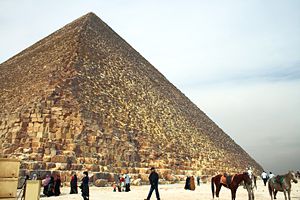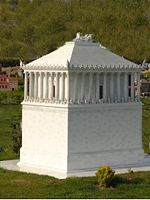Seven Wonders of the Ancient World: Difference between revisions
imported>Martin Baldwin-Edwards |
imported>Martin Baldwin-Edwards (→Great Pyramid of Giza: reinstated image after copyright issue sorted) |
||
| Line 7: | Line 7: | ||
:''Main Article: [[Great Pyramid of Giza]]'' | :''Main Article: [[Great Pyramid of Giza]]'' | ||
[[Image:Great Pyramid of Giza.jpg|thumbnail|300px|right|Great Pyramid of Giza]] | |||
The Great Pyramid of Giza, also known as Khufu's Pyramid is the oldest and largest of the three pyramids in the Giza complex. In fact, it was he tallest man-made structure for 3,800 years. It was constructed in just 20 years, culminating around 2560 BC, a feat far beyond the engineering capabilities of the rest of the world for many years to come. It is believed to be built as a tomb for Egyptian king [[Khufu]], known to the Greeks as [[Cheops]]. | The Great Pyramid of Giza, also known as Khufu's Pyramid is the oldest and largest of the three pyramids in the Giza complex. In fact, it was he tallest man-made structure for 3,800 years. It was constructed in just 20 years, culminating around 2560 BC, a feat far beyond the engineering capabilities of the rest of the world for many years to come. It is believed to be built as a tomb for Egyptian king [[Khufu]], known to the Greeks as [[Cheops]]. | ||
Revision as of 17:24, 22 January 2011
The Seven Wonders of the Ancient World is a well known list of seven remarkable constructions of classical antiquity. It was based on guide books popular among Hellenic (Greek) tourists, and only includes works located near the Mediterranean Rim. Written by Philo of Byzantium in 225 BC, the traditional list was neither the first, nor the last of such lists. The original Greek category was not "Wonders" but theamata, which translates closer to "things to be seen". The number seven was chosen because Greeks believed it to be magical.
Great Pyramid of Giza
- Main Article: Great Pyramid of Giza
The Great Pyramid of Giza, also known as Khufu's Pyramid is the oldest and largest of the three pyramids in the Giza complex. In fact, it was he tallest man-made structure for 3,800 years. It was constructed in just 20 years, culminating around 2560 BC, a feat far beyond the engineering capabilities of the rest of the world for many years to come. It is believed to be built as a tomb for Egyptian king Khufu, known to the Greeks as Cheops.
There are three known chambers. The first to be constructed was the chamber known only as "the unfinished chamber". It was cut into the bedrock and left unfinished. The second chamber is the Queen's chamber, which is located further up, in the structure of the pyramid itself. The final chamber is called the King's chamber, and is located roughly in the center of the pyramid.
The four sides of the pyramid closely correlate to the cardinal directions on a compass, north, south, east, and west.
It is the only Wonder of the Ancient World that is still standing.
Hanging Gardens of Babylon
- Main Article:Hanging Gardens of Babylon
The Hanging Gardens of Babylon, also known as the Hanging Gardens of Semiramis, where built by Nebuchadnezzar II around 600 BCE, to please his sick wife who longed for the fragrance and natural beauty of the plants and trees of her homeland Persia. It was first described by Berossus, a Chaldean priest in the fourth century BCE. It was later documented by historians such as Strabo and Diodorus Siculus. The location may have been confused with gardens in Nimrud, due to tablets from the area depicting gardens of nearly the same scale. It is said to have been destroyed by earthquakes in the second century BCE.
The Hanging Gardens have never been proven to exist. There is much controversy regarding whether the gardens were an actual creation, or merely a poetic creation. The theories are bolstered by the lack of documentation of the Hanging Gardens in the chronicles of Babylonian History.
Statue of Zeus at Olympia
- Main Article:Statue of Zeus at Olympia
The Statue of Zeus at Olympia was made by Greek sculptor of the Classical period, Phidias, around 432 BCE, in the Temple of Zeus, Olympia, Greece. The seated statue of Zeus, made entirely of ivory and gold plated bronze, was 39 ft (11.89 m) tall, and occupied the entire width of the aisle of the temple built to house it.
Eleventh century historian Georios Kedrenos recorded that it had been carried off to Constantinople, where it was destroyed in the great fire of the Lauseion in 475. Others claim that it perished when the Temple of Zeus burned in 425.
Temple of Artemis at Ephesus
The Temple of Artemis, also known inaccurately as the Temple of Diana, was a Greek temple dedicated to Artemis, the goddess of forests and hills, child birth, virginity, fertility, and the hunt. The temple, in it's most famous phase, was completed around 550 BC at Ephesus, in present day Turkey.
The first temple was destroyed by a flood in the seventh century, and by 550 BCE they built the "new" temple. The construction had taken nearly 120 years. It was designed and constructed by the Cretan architecht Chersiphron and his son Metagenes.
This temple was destroyed on July 21, 356 BCE in an act of arson committed by Herostratus. According to the story his motivation was "fame at any cost". The very same day, Alexander the Great was born, and Plutarch remarked that Artemis was too preoccupied with Alexanders delivery to save her burning temple. Alexander later offered to pay for the rebuilding of the temple, however the Ephesians refused. Eventually, the temple was restored after Alexander's death, in 323 BC.
This reconstruction was destroyed in a raid by the Goths in 262.
The Ephesians rebuilt the temple again. According to the second-century Acts of John, the apostle John prayed publicly at the temple, exorcising its demons and "the altar of Artemis split in many pieces...and half the temple fell down."
The temple was rebuilt once more, and destroyed by a mob, led by St. John Chrysostom in 401.
Mausoleum of Mausolus at Halicarnassus
- Main Article:Mausoleum of Mausolus at Halicarnassus
The Mausoleum of Mausolus at Halicarnassus, also known as the Tomb of Mausolus, Mausoleum of Mausolus, or the Mausoleum at Halicarnassus, is a tomb built for Mausolus and his wife Atemisia II of Caria. It was built between 353 and 350 BCE at Halicarnassus (present day Bedrum, Turkey. It was designed by Greek architects Satyros and Pythis. It stood 135 ft (41.15 m) tall, and each side was adorned with sculptural reliefs created by four Greek sculptors: Scopas of Paros who supervised the rebuilding of the Temple of Artemis at Ephesus, Leochares, Bryaxis, and Timotheus.
The tomb stood for nearly sixteen centuries before a series of earthquakes reduced the majestic monument to rubble. By 1404 AD only the base of the temple was recognizable, and today very little remains.
Colossus of Rhodes
- Main Article:Colossus of Rhodes
The Colossus of Rhodes was a statue of the Greek god Helios that stood 107 ft (32.61 m) tall. It was built on the Greek island of Rhodes by Chares of Lindos between 292 and 280 BCE.
It stood for 56 years until an earthquake destroyed it in 226 BCE. The statue snapped at the knees and fell onto the land, where it lay for nearly 800 years. In 654 caliph Muawiyah captured Rhodes and the remains of the colossus were sold to a "Jewish merchant of Edessa".
In November 2008 it was announced that the Colossus of Rhodes would be rebuilt, taller than the original.[1]
Lighthouse of Alexandria
- Main Article:Lighthouse of Alexandria
The Lighthouse of Alexandria, also known as the Pharos of Alexandria, was built between 285 and 247 BCE as a landmark for the city of Alexandria. The height of the lighthouse is estimated to have been 380-440 ft (116-134 m) tall, making it the third tallest building of its time, after the two Great Pyramids (of Khufu and Khafra). It was converted to a lighthouse sometime around the first century AD.
It was badly damaged in an earthquake in 956 and again in 1303 and 1323. It finally disappeared completely in 1480 when Fort Qaitbey was built on the site in the 15th century, using some of its fallen masonry.
The Lighthouse of Alexandria survived the longest of the six fallen wonders.
References
- ↑ Colossus of Rhodes to be rebuilt as giant light sculpture (2008-11-17). Retrieved on 2011-01-21.



